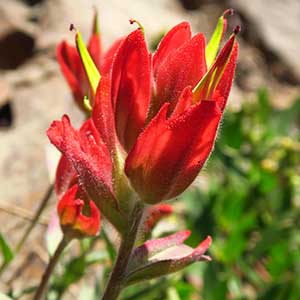Castilleja collegiorum
Castilleja elmeri
colleagues paintbrush, collegial paintbrush
Elmer's Indian paintbrush, Elmer's paintbrush, Wenatchee Indian paintbrush, Wenatchee paintbrush
few to many, erect or ascending, short-decumbent at base, unbranched, hairs dense, spreading to erect, ± short, soft, usually stipitate-glandular, longer ones sometimes eglandular.
solitary or few to many, erect to ascending, sometimes slightly curved at base, unbranched, rarely branched, hairs moderately dense, spreading, medium length, soft, mixed with shorter eglandular and stipitate-glandular ones, at least on distal 1/2 of stem.
pale green to dull reddish maroon, linear to linear-lanceolate, 0.8–3.5 cm, not fleshy, margins plane, slightly involute, 0–3(–5)-lobed, apex acuminate;
lateral lobes ascending to spreading, linear-lanceolate, usually arising from distal 1/2 of blade, usually narrower than central lobe, apex acuminate to acute.
green, rarely purple-tinged, linear-lanceolate, sometimes linear or lanceolate, 1.3–6.5 cm, not fleshy, margins plane, flat or involute, entire, apex acute.
10–40(–80 with age) × 0.5–2.5 cm;
bracts pale cream to pale greenish yellow throughout, often partly to entirely suffused with dull reddish purple to maroon, especially proximally, along veins, and with age, sometimes distal apices pale, dullish red, lanceolate to ovate, usually 3-lobed, central lobe sometimes with short teeth;
lobes spreading-ascending, linear-lanceolate, short to medium length, arising at or above mid length, apex acute.
2.5–9 × 1.5–3 cm;
bracts red, crimson, scarlet, pink, magenta, red-orange, burnt orange, orange, pale yellow, or whitish throughout, or proximally greenish, distally as stated above, oblong, narrowly obovate, elliptic-oblong, or narrowly ovate, 0(–5)-lobed, rarely with 1 or 2 pairs of short, usually distal lobes;
lobes ascending, lanceolate, very short, arising from distal edge, apex rounded to obtuse.
0 mm.
straight, 16.5–25 mm;
tube 12–18 mm;
beak scarcely exserted, adaxially pale green to yellowish, 3–7 mm;
abaxial lip green, not inflated, grooved, 2.5 mm, 33–50% as long as beak;
teeth slightly incurved, white, 1 mm.
straight, 20–33 mm;
tubes 13–18 mm;
beak, and sometimes abaxial lip, partially to fully exserted;
beak adaxially green to yellowish, 8–15 mm;
abaxial lip incurved, green, thickened, 2–3 mm, 20–33% as long as beak;
teeth ascending or incurved, green, 0.5–1 mm.
pale cream to pale greenish yellow, sometimes reddish violet to maroon on distal segments and/or with a thin vertical strip of pale reddish violet to maroon along veins, 11–20 mm;
abaxial and adaxial clefts 7–12 mm, 60% of calyx length, deeper than laterals, lateral 0.5–1 mm, 5–10% of calyx length;
lobes triangular, apex acute to obtuse.
proximally green to pale green, distally colored as bracts, 15–25 mm;
abaxial and adaxial clefts 5–14 mm, 33–50% of calyx length, deeper than laterals, lateral 1–4 mm, 6–20% of calyx length;
lobes lanceolate to narrowly triangular, apex rounded to obtuse.
= 48.
Castilleja collegiorum
Castilleja elmeri
Castilleja collegiorum is endemic to a large meadow system in the southern Cascade Range of Klamath County. It is similar to C. cryptantha in Washington and C. lemmonii in California but differs from both in structural details of the inflorescence, calyx, bracts, and leaves.
(Discussion copyrighted by Flora of North America; reprinted with permission.)
The bracts and inflorescences of Castilleja elmeri can be red, crimson, scarlet, pink, magenta, red-orange, burnt orange, orange, pale yellow, or whitish. While the coloration is highly variable between local populations, it is usually uniform and consistent within them. It is found primarily in the Wenatchee Mountains of Washington, where it is often on serpentine, but it ranges northward in the Cascades into extreme southern British Columbia, apparently on non-serpentine substrates. Hybrids with C. miniata var. miniata, C. parviflora var. albida, and C. thompsonii have been found in the eastern Cascades of Washington, and a similar hybrid swarm with C. thompsonii is reported from southern British Columbia.
(Discussion copyrighted by Flora of North America; reprinted with permission.)
- Local floras:
OR
- Local Web sites:
Flora NW,
PNW Herbaria
WildflowerSearch
iNaturalist (observations)
- LBJ Wildflower Center
- SEINet
- Plants of the World Online
- Encyclopedia of Life
- Wikipedia
- Google Image Search


